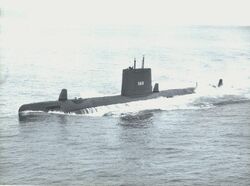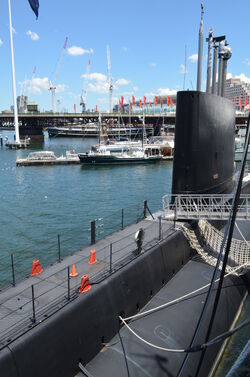
USS Harder with the three distinctive shark-fin PUFFS domes.
What is 'sonar'?[]

Fin and central section of HMAS Onslow. The three orange covers on the casing are protective sheathes over the submarine's Micropuffs sonar.
Sonar was (originally an acronym for: SOund Navigation And Ranging), wich is a technique that uses sound propagation (usually underwater, as in submarine navigation) to navigate, communicate with or detect objects on or under the surface of the water, such as other vessels. Two types of technology share the name "sonar": passive sonar is essentially listening for the sound made by vessels; active sonar is emitting pulses of sounds and listening for echoes. Sonar may be used as a means of acoustic location and of measurement of the echo characteristics of "targets" in the water. Acoustic location in air was used before the introduction of radar. Sonar may also be used in air for robot navigation, and SODAR (an upward looking in-air sonar) is used for atmospheric investigations. The term sonar is also used for the equipment used to generate and receive the sound. The acoustic frequencies used in sonar systems vary from very low (infrasonic) to extremely high (ultrasonic). The study of underwater sound is known as underwater acoustics or hydroacoustics.
What is 'passive sonar'?[]
Passive sonar listens without transmitting. It is often employed in military settings, although it is also used in science applications, e.g., detecting fish for presence/absence studies in various aquatic environments - see also passive acoustics and passive radar. In the very broadest usage, this term can encompass virtually any analytical technique involving remotely generated sound, though it is usually restricted to techniques applied in an aquatic environment.
What is 'active sonar'?[]
Active sonar uses a sound transmitter and a receiver. When the two are in the same place it is monostatic operation. When the transmitter and receiver are separated it is bistatic operation. When more transmitters (or more receivers) are used, again spatially separated, it is multistatic operation. Most sonars are used monostatically with the same array often being used for transmission and reception. Active sonobuoy fields may be operated multistatically.
Active sonar creates a pulse of sound, often called a "ping", and then listens for reflections (echo) of the pulse. This pulse of sound is generally created electronically using a sonar projector consisting of a signal generator, power amplifier and electro-acoustic transducer/array. A beamformer is usually employed to concentrate the acoustic power into a beam, which may be swept to cover the required search angles. Generally, the electro-acoustic transducers are of the Tonpilz type and their design may be optimised to achieve maximum efficiency over the widest bandwidth, in order to optimise performance of the overall system. Occasionally, the acoustic pulse may be created by other means, e.g. (1) chemically using explosives, or (2) airguns or (3) plasma sound sources.
To measure the distance to an object, the time from transmission of a pulse to reception is measured and converted into a range by knowing the speed of sound. To measure the bearing, several hydrophones are used, and the set measures the relative arrival time to each, or with an array of hydrophones, by measuring the relative amplitude in beams formed through a process called beamforming. Use of an array reduces the spatial response so that to provide wide cover multibeam systems are used. The target signal (if present) together with noise is then passed through various forms of signal processing, which for simple sonars may be just energy measurement. It is then presented to some form of decision device that calls the output either the required signal or noise. This decision device may be an operator with headphones or a display, or in more sophisticated sonars this function may be carried out by software. Further processes may be carried out to classify the target and localise it, as well as measuring its velocity.
The pulse may be at constant frequency or a chirp of changing frequency (to allow pulse compression on reception). Simple sonars generally use the former with a filter wide enough to cover possible Doppler changes due to target movement, while more complex ones generally include the latter technique. Since digital processing became available pulse compression has usually been implemented using digital correlation techniques. Military sonars often have multiple beams to provide all-round cover while simple ones only cover a narrow arc, although the beam may be rotated, relatively slowly, by mechanical scanning.
Particularly when single frequency transmissions are used, the Doppler effect can be used to measure the radial speed of a target. The difference in frequency between the transmitted and received signal is measured and converted into a velocity. Since Doppler shifts can be introduced by either receiver or target motion, allowance has to be made for the radial speed of the searching platform.
One useful small sonar is similar in appearance to a waterproof flashlight. The head is pointed into the water, a button is pressed, and the device displays the distance to the target. Another variant is a "fishfinder" that shows a small display with shoals of fish. Some civilian sonars (which are not designed for stealth) approach active military sonars in capability, with quite exotic three-dimensional displays of the area near the boat.
When active sonar is used to measure the distance from the transducer to the bottom, it is known as echo sounding. Similar methods may be used looking upward for wave measurement.
Active sonar is also used to measure distance through water between two sonar transducers or a combination of a hydrophone (underwater acoustic microphone) and projector (underwater acoustic speaker). A transducer is a device that can transmit and receive acoustic signals ("pings"). When a hydrophone/transducer receives a specific interrogation signal it responds by transmitting a specific reply signal. To measure distance, one transducer/projector transmits an interrogation signal and measures the time between this transmission and the receipt of the other transducer/hydrophone reply. The time difference, scaled by the speed of sound through water and divided by two, is the distance between the two platforms. This technique, when used with multiple transducers/hydrophones/projectors, can calculate the relative positions of static and moving objects in water.
In combat situations, an active pulse can be detected by an opponent and will reveal a submarine's position.
A very directional, but low-efficiency, type of sonar (used by fisheries, military, and for port security) makes use of a complex nonlinear feature of water known as non-linear sonar, the virtual transducer being known as a 'parametric array'.
Project Artemis[]
Project Artemis was a one-of-a-kind low-frequency sonar for surveillance that was deployed off Bermuda for several years in the early 1960s. The active portion was deployed from a World War II tanker, and the receiving array was a built into a fixed position on an offshore bank.
Transponders[]
This is an active sonar device that receives a stimulus and immediately (or with a delay) retransmits the received signal or a predetermined one.
Also see[]
- Radar
- Passive Underwater Fire Control Feasibility System (PUFFS)
- GIUK gap
- SOSUS sonar buoy line
- Submarines
- Torpedoes
Sources[]
- https://en.wikipedia.org/wiki/Passive_Underwater_Fire_Control_Feasibility_System
- http://www.acronymfinder.com/PUFFS.html
- http://www.digplanet.com/wiki/Passive_Underwater_Fire_Control_Feasibility_System
- http://acronyms.thefreedictionary.com/Passive+Underwater+Fire+Control+Feasibility+System
- https://images.search.yahoo.com/search/images;_ylt=A0LEV0fqQzhYpYsArBpXNyoA;_ylu=X3oDMTEyNGJsOGU5BGNvbG8DYmYxBHBvcwMxBHZ0aWQDQjMxMTNfMQRzZWMDc2M-?p=Passive+Sonar&fr=dss_yset_chr
- http://oceanservice.noaa.gov/facts/sonar.html
- http://encyclopedia2.thefreedictionary.com/Passive+sonar
- http://www.tutapoint.com/knowledge-center/view/passive-vs-active-sonar/
- https://www.wikiwand.com/en/Sonar#/Passive_sonar
- https://www.wikiwand.com/en/Sonar#/Active_sonar
- https://en.wikipedia.org/wiki/Sonar#Active_sonar
- https://images.search.yahoo.com/search/images;_ylt=A0LEVxpvVUBYLzoAjDhXNyoA;_ylu=X3oDMTEyMm43aWFsBGNvbG8DYmYxBHBvcwMxBHZ0aWQDQjE5MTBfMQRzZWMDc2M-?p=Active+Sonar&fr=yset_chr_cnewtab
- https://www.quora.com/What-is-active-sonar
- http://oceanexplorer.noaa.gov/technology/tools/sonar/sonar.html
- http://www.tutapoint.com/knowledge-center/view/passive-vs-active-sonar/
- http://oceanservice.noaa.gov/facts/sonar.html
- https://www.justice.gov/enrd/mid-and-low-frequency-sonar
- http://subs.emis.de/LNI/Proceedings/Proceedings154/gi-proc-154-208.pdf